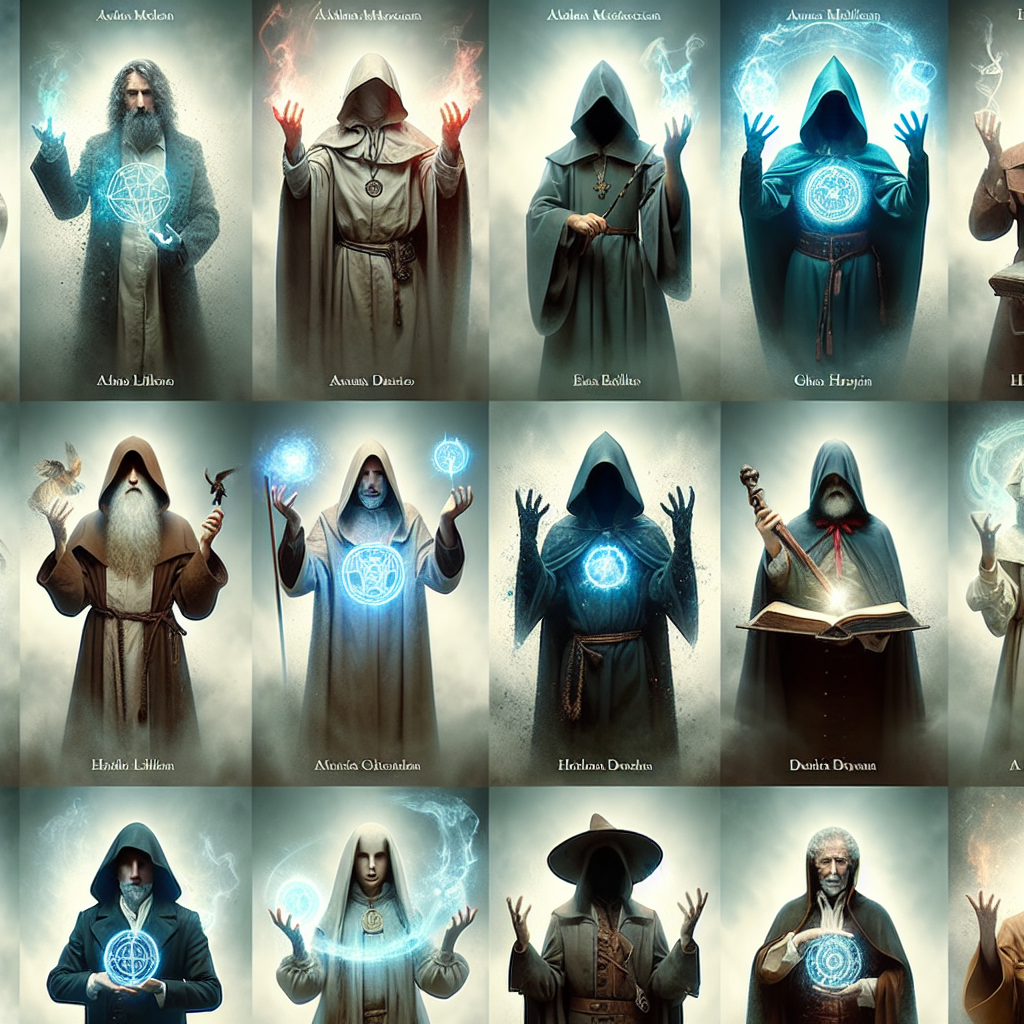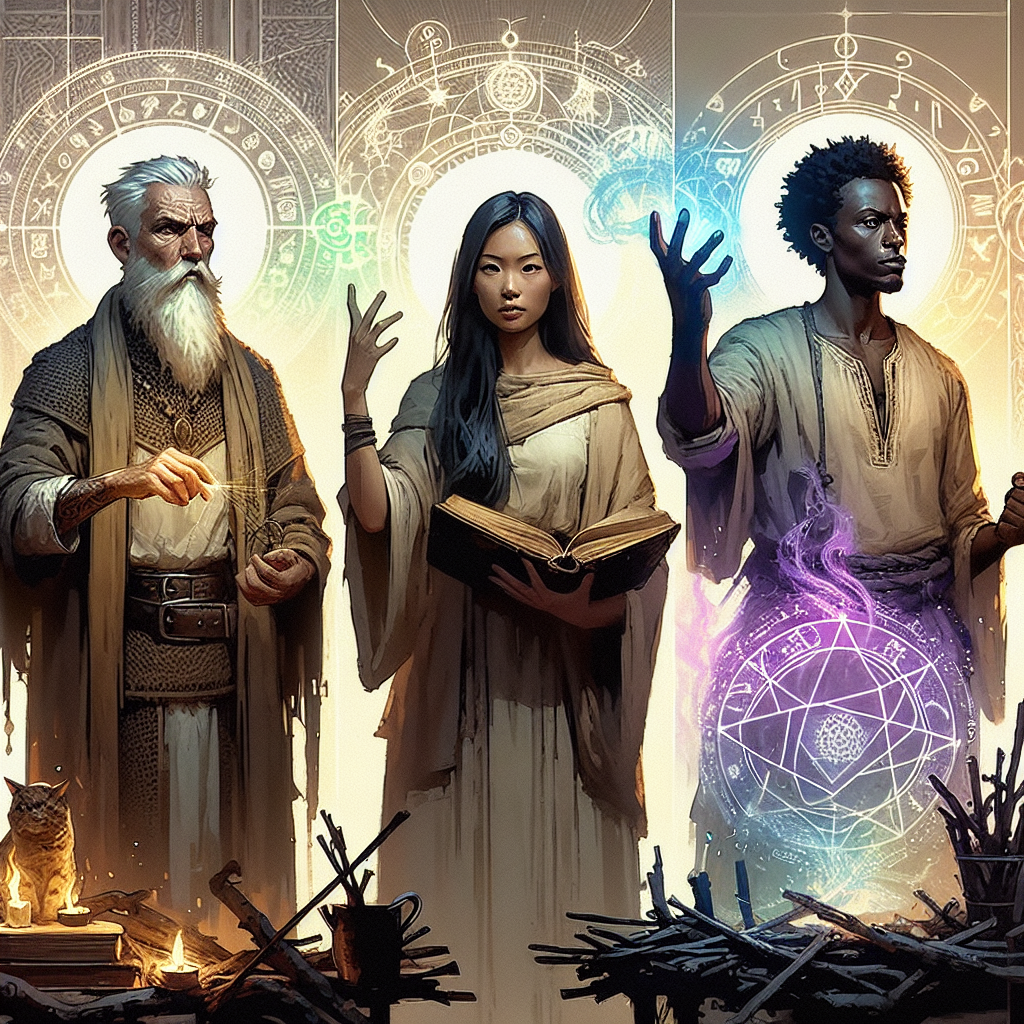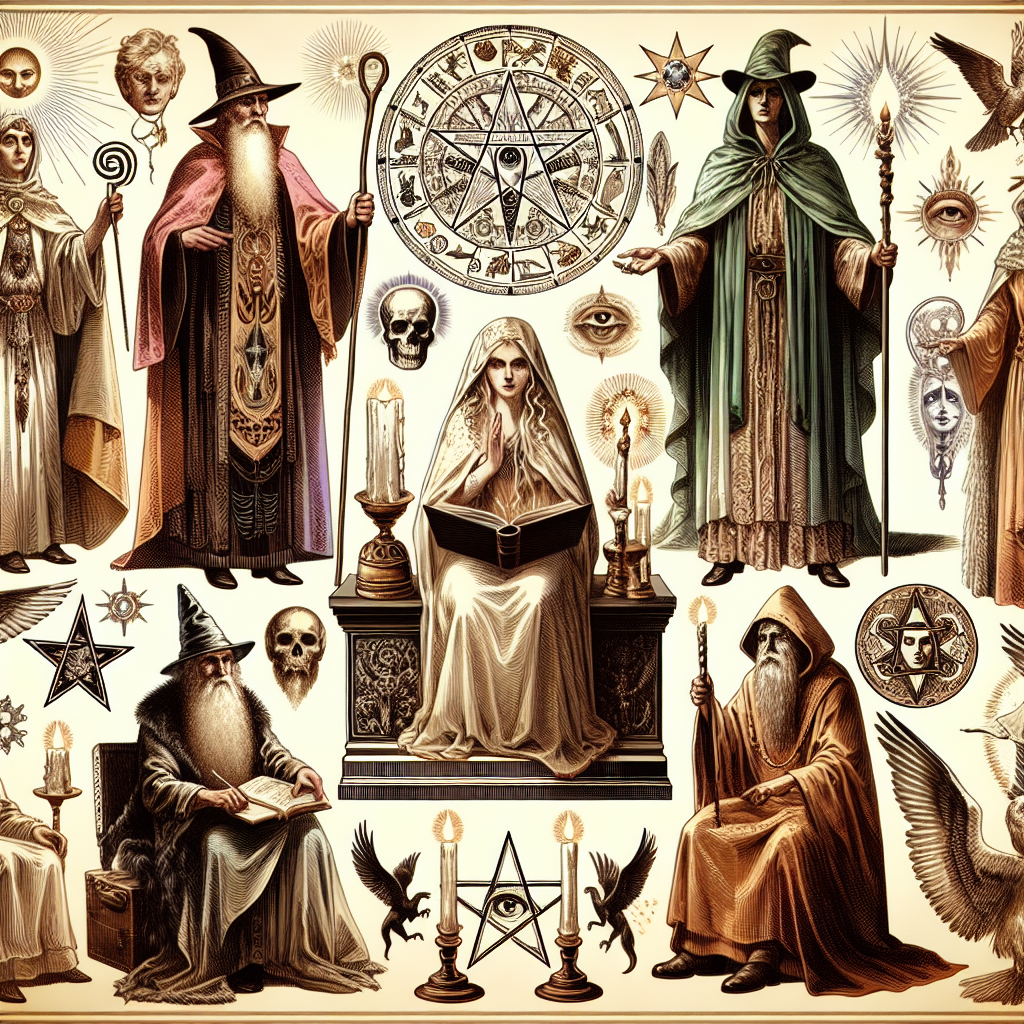As an Amazon Associate I earn from qualifying purchases.

14 Figures Who Revolutionized Modern Magick
Introduction
In the realm of modern spirituality, few areas are as enigmatic and compelling as magick. Defined broadly as the science and art of causing change to occur in conformity with will, according to Aleister Crowley, magick has captured imaginations and inspired seekers for centuries. The evolution of modern magick can be traced back through history and pinpointed to 14 influential figures who have left an indelible mark on its practice and theory. These visionaries not only shaped the practice but also contributed significantly to its global popularity and the development of various traditions. In recent years, the growing number of individuals identifying as practitioners of magick—a 60% increase over the past decade—demonstrates its resurgent relevance.
Eliphas Levi
A key figure in the integration of occultism with mystical philosophies, Eliphas Levi is often credited as the father of modern ceremonial magick. His works brought about a renaissance in the arts of Tarot and Kabbalah, intertwining Christian mysticism with the evolving magickal traditions of his time. Levi’s synthesis of magickal theories has had far-reaching influences, impacting subsequent generations of magicians and scholars alike.
Helena Blavatsky
Co-founder of the Theosophical Society, Helena Blavatsky, sought to bridge the gap between Eastern and Western esoteric traditions. Her seminal works, “The Secret Doctrine” and “Isis Unveiled,” proposed a unified theory of occult knowledge and spiritual sciences. Blavatsky’s influence went beyond mere literature; she cultivated a global awareness of esoteric schools of thought, igniting interest in mystical and magickal studies across various cultures.
Aleister Crowley
Perhaps no one has left a more controversial and intriguing legacy in modern magick than Aleister Crowley. Known for his extensive writings and pioneering of the religious philosophy Thelema, Crowley introduced revolutionary concepts that have become foundational elements in current magickal practices. His provocative lifestyle and bold declarations earned him the title “The Great Beast,” and his works continue to inspire and challenge magicians around the world.
Dion Fortune
Dion Fortune, a significant figure in the development of modern psychic self-defense and practical magick, founded the Society of the Inner Light. Her writings on mysticism and Kabbalah remain highly respected and widely read in magickal circles today. Fortune’s contributions were seminal in establishing the role of psychology in magickal practice, laying groundwork for future integration of modern science with ancient wisdom.
Israel Regardie
As a secretary and student of Aleister Crowley, Israel Regardie played a crucial role in preserving and disseminating Crowley’s teachings. Regardie’s own contributions to magickal literature, particularly “The Golden Dawn,” offered a structured and accessible framework for aspiring magicians. His work ensured that the wisdom of the Hermetic Order of the Golden Dawn would be preserved for future generations.
Gerald Gardner
Gerald Gardner, often considered the father of modern Wicca, heralded a new era of magickal practice. Blending elements of ancient pagan traditions with contemporary innovations, Gardner’s Wicca provided an accessible entry point to magick for many. His belief in the ritualistic expression of magick and nature worship continues to resonate deeply with practitioners around the globe.
Margaret Murray
Margaret Murray’s work as an anthropologist and historian brought academic credibility to the study of witchcraft and magick. Her research posited the existence of a pre-Christian, pan-European witch-cult, a hypothesis that, despite criticism, has had a lasting impact on both scholarly debates and popular perceptions of witchcraft. Murray’s scholarship played a vital role in validating the historical roots of contemporary pagan practices.
Carlos Castaneda
Carlos Castaneda’s series of books detailing his apprenticeship with a Yaqui shaman, Don Juan Matus, introduced the concept of magick as a path to personal enlightenment and transformation. Castaneda’s descriptions of altered states of consciousness and shamanic journeys captivated readers and expanded the Western understanding of magickal and spiritual practices. His work remains both influential and controversial.
Raymond Buckland
Known as the father of American Wicca, Raymond Buckland was instrumental in bringing Gardnerian Wicca to the United States. His extensive writings and teachings helped to establish a robust infrastructure for Wiccan practitioners in North America, greatly influencing the growth and development of Wiccan traditions. Buckland’s contributions have secured his place among the most pivotal figures in modern magick.
Starhawk
As a prominent author and activist, Starhawk has significantly shaped the feminist and eco-conscious dimensions of contemporary witchcraft and magick. Her book “The Spiral Dance” remains a seminal text in the field, advocating for the integration of social justice, environmentalism, and spirituality. Starhawk’s work continues to inspire new generations of witches and magicians dedicated to creating positive change in the world.
Robert Anton Wilson
A novelist and philosopher, Robert Anton Wilson explored the more cerebral and chaos-centered aspects of magick and esotericism. His writings, particularly “The Illuminatus! Trilogy,” infused magick with a contemporary, counter-culture ethos. Wilson’s approach encouraged skepticism, experimentation, and a playful irreverence, attributes that have deeply influenced modern interpretations of magickal practice.
Janet and Stewart Farrar
The husband-and-wife team of Janet and Stewart Farrar made significant contributions through both their written works and personal practices. They authored influential books that demystified witchcraft and made it accessible to a wider audience. Their work in Alexandrian Wicca and the creation of comprehensive guides for ritual practices amplified and diversified the magickal landscape.
Scott Cunningham
Scott Cunningham’s down-to-earth and practical approach to solitary witchcraft has made him a beloved figure among modern pagans. His numerous books, including “Wicca: A Guide for the Solitary Practitioner,” offer simple yet profound insights into personal magickal practice. Cunningham’s accessible style and emphasis on individual spirituality have empowered countless practitioners to explore and embrace magick.
Lon Milo DuQuette
An influential spokesperson for Thelema and a prolific author, Lon Milo DuQuette has demystified complex magickal concepts for modern audiences. Through his writings, workshops, and lectures, DuQuette has made esoteric knowledge more accessible and engaging. His work continues to educate and inspire, cementing his status as a vital link in the ongoing evolution of modern magick.
Aleister Crowley: Often cited as the most influential figure in modern magick, Aleister Crowley founded Thelema and authored a multitude of texts that continue to shape contemporary esoteric practices. His principles of “Do what thou wilt” and “Love is the law” remain foundational in the study of Western occultism.
Helena Blavatsky: Co-founder of the Theosophical Society, Helena Blavatsky integrated Eastern spirituality with Western esoteric traditions. Her works, including “The Secret Doctrine,” laid the cornerstone for modern occult study and influenced many spiritual influencers and magical pioneers.
Gerald Gardner: Known as the father of modern Wicca, Gerald Gardner brought witchcraft to public attention post-World War II. His books, “Witchcraft Today” and “The Meaning of Witchcraft,” established the basics of contemporary Wiccan practice, emphasizing rituals, covens, and the worship of the Goddess and the Horned God.
Dion Fortune: A pioneering force in the revival of Western esoteric traditions, Dion Fortune authored significant works like “The Mystical Qabalah,” bridging the gap between psychological understanding and mystical practices. Her foundation, the Society of the Inner Light, continues to be a pivotal magickal organization.
Israel Regardie: As a significant figure within the Hermetic Order of the Golden Dawn, Israel Regardie made magickal practices more accessible through his writings, notably “The Golden Dawn” compendium. His work helped sustain and spread the Order’s influence on modern ceremonial magick.
Anton LaVey: Founder of the Church of Satan, Anton LaVey’s publication of The Satanic Bible in 1969 revolutionized modern Satanism. LaVey’s work challenged traditional religious ideologies and carved out a space for atheistic and humanistic interpretations of satanic rituals.
Carlos Castaneda: An enigmatic and controversial figure, Carlos Castaneda authored a series of books describing his shamanic training under a Yaqui Indian sorcerer, Don Juan Matus. His works, like “The Teachings of Don Juan,” sparked widespread interest in native magickal and shamanic practices.
Patricia Crowther: Among the earliest and most outspoken witches in Britain, Patricia Crowther made significant contributions to the spread of Wicca. Her books and public appearances helped demystify witchcraft and provided practical guidance for budding witches and rituals.
Margot Adler: A journalist and Wiccan priestess, Margot Adler’s “Drawing Down the Moon” serves as a comprehensive survey of Neopagan movements in America. Her work offered sociological insights and personal narratives, making it a seminal text for anyone exploring modern witchcraft.
Raymond Buckland: Often referred to as the person who brought Gardnerian Wicca to the United States, Raymond Buckland authored many instructive books, including “Buckland’s Complete Book of Witchcraft,” which remains a staple for those training in the Craft.
Stewart and Janet Farrar: The duo co-authored several influential books, including “A Witches’ Bible” and “The Witches’ Way.” As essential magickal figures, their works have offered elaborate rituals and coven structures, blending research with practical insights.
Starhawk: A strong advocate for feminist spirituality and eco-feminism, Starhawk’s book “The Spiral Dance” has been a cornerstone for Goddess-worshiping witchcraft. Her activism and teachings have inspired many to merge their spiritual and social justice work.
Feri Tradition Founders: Victor and Cora Anderson co-founded the Feri Tradition, an eclectic, ecstatic path within American witchcraft. Their teachings integrated Polynesian, African, and European elements, creating a deeply mystical and sexually liberated witchcraft system.
Paul Huson: An author and esotericist, Paul Huson’s “Mastering Witchcraft” was one of the first books to provide a practical guide to witchcraft, blending ceremonial magick with traditional folk practices. His work remains a significant influence on solitary witches and coven members alike.
According to a 2021 Pew Research Center report, approximately 0.4% of U.S. adults identify as Pagans or Wiccans, highlighting the growing interest and commitment to these revived and evolving spiritual paths.
Aleister Crowley
My first encounter with Aleister Crowley’s work was through his book “The Book of the Law.” The cryptic verses and the strong rebellious energy within them intrigued me immediately. Trying to grasp their deeper meanings, I found myself delving into supplementary materials he wrote on magick. His philosophy of “Do what thou wilt shall be the whole of the Law” resonated with my desire for personal freedom and expression.
Visiting the Abbey of Thelema in Cefalù, Sicily, was like stepping into a different dimension. The murals and symbols embedded in the walls seemed alive with spiritual significance. There, amidst the ruin, I felt a kind of connection to those who practiced with Crowley, sensing their aspirations and struggles.
Engaging with Crowley’s rituals and ceremonies had a transformative impact on my spiritual practice. The structure and intensity of his rituals, combined with his use of symbolism, brought about profound experiences. His teachings pushed me to explore the boundaries of my consciousness and find new depths in my understanding of magick.
Dion Fortune
Reading “The Mystical Qabalah” by Dion Fortune opened my eyes to the interconnectedness of different esoteric traditions. Her clear explanations of the Sephiroth and the paths on the Tree of Life made complex concepts accessible. These teachings became a cornerstone of my own magickal practice, helping me to integrate various esoteric teachings into a cohesive whole.
Joining a study group focused on Fortune’s work was a pivotal moment in my magickal journey. The group’s discussions were enlightening, revealing layers of meaning I had initially overlooked. This collaborative exploration not only deepened my understanding of her work but also built a supportive community of like-minded practitioners.
Her emphasis on the practical application of esoteric principles inspired me to incorporate magick into my daily life. Through her teachings, I learned to view every aspect of existence as a potential manifestation of the divine. This holistic approach enriched my spiritual practice, making each day a sacred experience.
Israel Regardie
Israel Regardie’s work on the Golden Dawn rituals provided me with a structured framework for my magickal studies. His detailed descriptions of rituals, invocations, and meditations created a solid foundation for my practice. Following these routines brought a sense of discipline and order to my spiritual endeavors.
When I attended a workshop based on Regardie’s teachings, I felt like a new world had opened up to me. The practical exercises and shared experiences of the participants amplified my understanding of ceremonial magick. It was gratifying to watch others grow and transform alongside me, reinforcing my commitment to this path.
Integrating the middle pillar exercise into my daily routine, as suggested by Regardie, brought significant changes to my energetic body. The sense of alignment and grounding I achieved through this practice allowed me to navigate life’s challenges with greater resilience and clarity. His teachings offered tools that continue to support my magickal development to this day.
Gerald Gardner
My introduction to Gerald Gardner’s work came through “Witchcraft Today.” His historical perspective on modern witchcraft and the revival of pre-Christian practices was eye-opening. It made me appreciate the depth and richness of the Wiccan tradition, beyond the popularized stereotypes.
Participating in a Gardnerian coven was an unforgettable experience. The rituals, rooted in his teachings, felt both ancient and immediate. The sense of community and the shared reverence for the natural world were profound, creating a supportive environment where my spiritual and magickal practices could thrive.
Gardner’s emphasis on the balance of male and female energies, as well as the attunement to nature, resonated deeply with me. His work encouraged me to explore these principles in my own practice, leading to a more harmonious and balanced spiritual life. Through Gardner’s influence, I found a path that was both deeply personal and universally connected.
u003ch2u003e1. Who are some key figures who have influenced modern magick?u003c/h2u003e
u003cpu003eKey figures who have influenced modern magick include Aleister Crowley, Gerald Gardner, Doreen Valiente, Dion Fortune, and John Dee, among others. They have contributed significantly through their writings, practices, and the creation of magical systems.u003c/pu003e
u003ch2u003e2. How did Aleister Crowley revolutionize modern magick?u003c/h2u003e
u003cpu003eAleister Crowley revolutionized modern magick by developing the philosophy and practices of Thelema, an esoteric belief system centered around the idea of spiritual freedom and self-discovery. His works, such as “The Book of the Law,” continue to be highly influential.u003c/pu003e
u003ch2u003e3. Who is Gerald Gardner and what is his significance to modern witchcraft?u003c/h2u003e
u003cpu003eGerald Gardner is considered the father of modern Wicca. He is significant for popularizing and systematizing contemporary witchcraft practices, bringing them into the public eye through his books and coven work in the mid-20th century.u003c/pu003e
u003ch2u003e4. What contributions did Doreen Valiente make to modern magick?u003c/h2u003e
u003cpu003eDoreen Valiente made substantial contributions to modern magick by co-creating many of the rituals and liturgies of Wicca. Her poetic writings and extensive research have deeply influenced contemporary witchcraft and Pagan practices.u003c/pu003e
u003ch2u003e5. How did John Dee shape the practice of magick?u003c/h2u003e
u003cpu003eJohn Dee, a 16th-century mathematician and occultist, shaped the practice of magick through his work in developing Enochian magick, a system of angelic communication. His intricate scrying methods and spiritual journals have left a lasting impact on magickal traditions.u003c/pu003e
u003ch2u003e6. What is the role of Dion Fortune in the history of magick?u003c/h2u003e
u003cpu003eDion Fortune was pivotal in bridging Western esotericism and psychology, founding the Fraternity of the Inner Light, and writing influential texts like “The Mystical Qabalah.” Her work emphasized the importance of spiritual discipline and psychic self-defense.u003c/pu003e
u003ch2u003e7. Are there any influential female magickal figures?u003c/h2u003e
u003cpu003eYes, influential female magickal figures include Doreen Valiente, Dion Fortune, and Starhawk, among others. These women have played key roles in shaping modern witchcraft, feminist spirituality, and neopagan movements.u003c/pu003e
u003ch2u003e8. What impact did historical magick have on modern practices?u003c/h2u003e
u003cpu003eHistorical magick provided the foundation for many modern practices by preserving ancient rituals, spells, and metaphysical doctrines. Systems like Hermeticism, Alchemy, and Kabbalah have deeply influenced contemporary magickal traditions.u003c/pu003e
u003ch2u003e9. How did witchcraft leaders bring magick practices to mainstream awareness?u003c/h2u003e
u003cpu003eWitchcraft leaders like Gerald Gardner and Sybil Leek brought magick practices to mainstream awareness through their publications, public appearances, and the formation of accessible covens. Their work helped to demystify and destigmatize witchcraft in society.u003c/pu003e
u003ch2u003e10. What are some criticisms faced by magickal figures?u003c/h2u003e
u003cpu003eMagickal figures often face criticisms regarding the legitimacy of their practices, the commercialization of their teachings, and the ethical implications of their influence. Additionally, their work can attract skepticism from both the academic community and conservative religious groups.u003c/pu003e

## Conclusion
The article on 14 Figures Who Revolutionized Modern Magick highlights the pivotal roles played by various magickal figures, spiritual influencers, and magical pioneers in shaping the contemporary practice of witchcraft and magick. Key individuals like Aleister Crowley and Gerald Gardner have laid foundational elements for modern magickal systems such as Thelema and Wicca, respectively. Their contributions not only established significant esoteric frameworks but also influenced countless practitioners worldwide. Figures like Dion Fortune and William Butler Yeats bridged the gap between literary artistry and spiritual endeavor, embedding mystical teachings into broader cultural contexts. Historical educators like Eliphas Levi provided essential philosophical underpinnings while others, like Doreen Valiente, emphasized the integration of ancient traditions into modern practices.
Importantly, the article also acknowledges the vital contributions of lesser-known but equally impactful magickal figures who broadened the scope of magick and spirituality. For instance, figures like Sybil Leek and Zsuzsanna Budapest redefined the role of women in witchcraft, empowering a new generation of female practitioners. Innovators such as Israel Regardie and Anton LaVey introduced diverse perspectives, from the structured ceremonial magick of the Golden Dawn to the more theatrical elements of modern Satanism. These dynamic individuals, through their unique philosophies and practices, have enriched the tapestry of modern magick, ensuring its evolution and relevance in an ever-changing world. Collectively, these trailblazers have not only preserved historical wisdom but also catalyzed new spiritual movements, weaving a complex web of magical and spiritual legacies that continue to inspire and transform.
Amazon and the Amazon logo are trademarks of Amazon.com, Inc, or its affiliates.


